
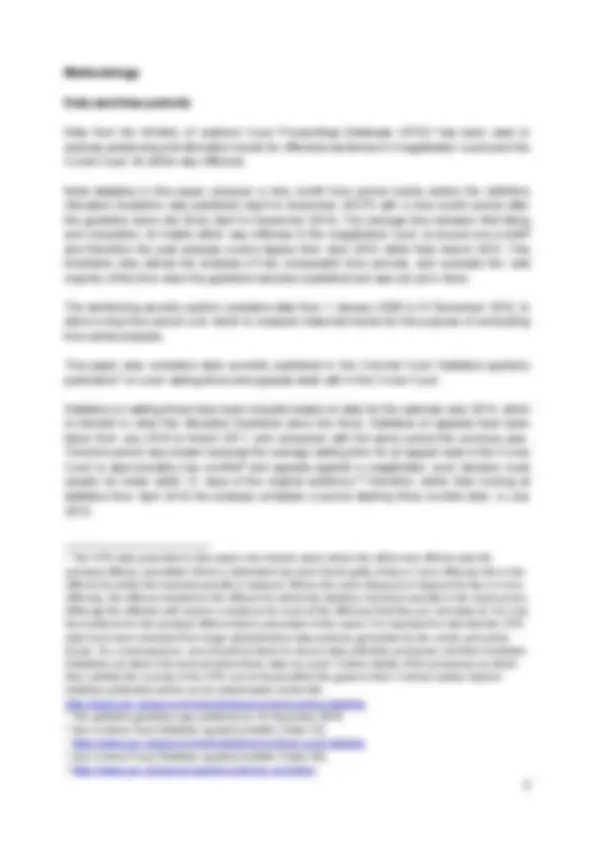
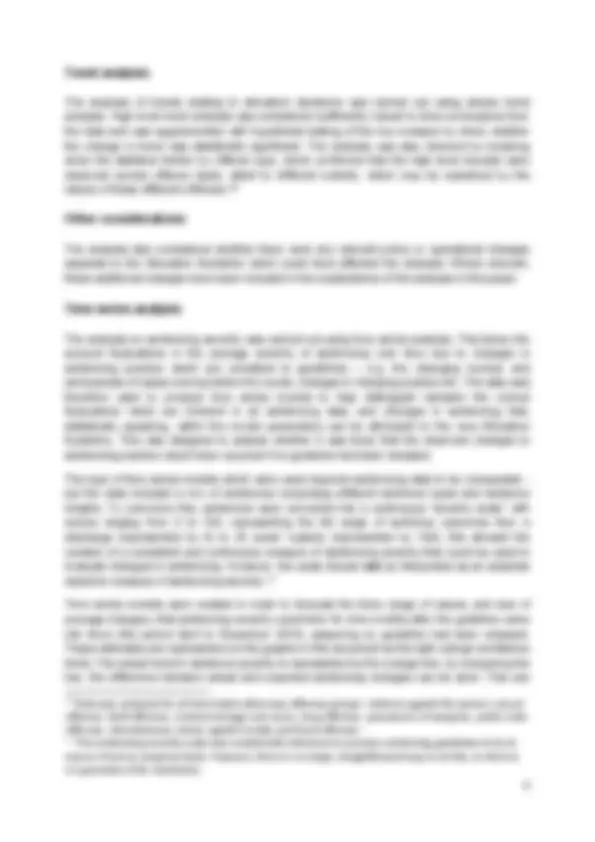

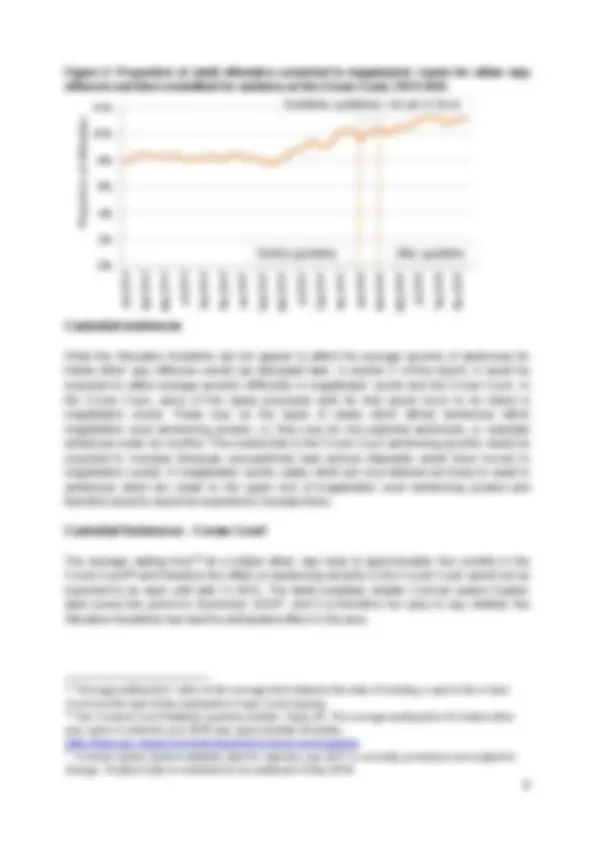
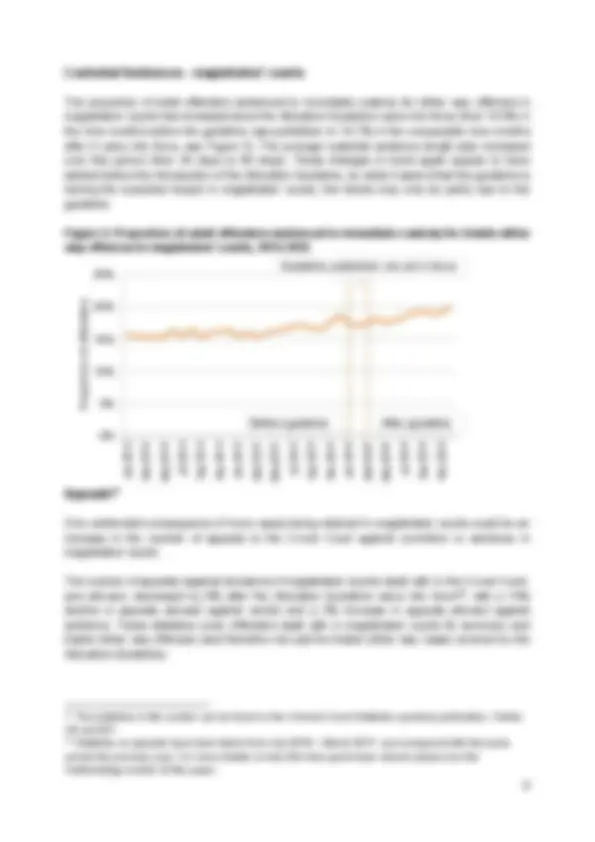
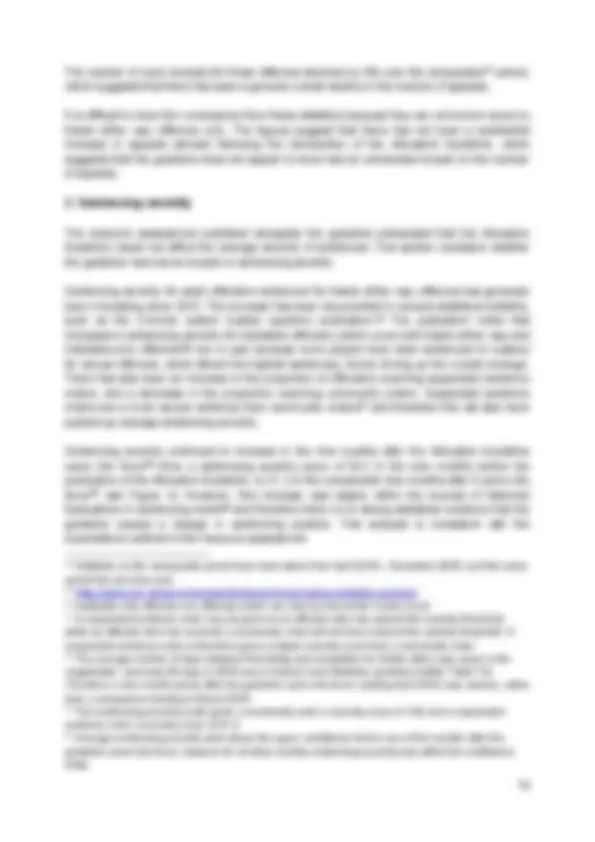


Study with the several resources on Docsity

Earn points by helping other students or get them with a premium plan


Prepare for your exams
Study with the several resources on Docsity

Earn points to download
Earn points by helping other students or get them with a premium plan
Community
Ask the community for help and clear up your study doubts
Discover the best universities in your country according to Docsity users
Free resources
Download our free guides on studying techniques, anxiety management strategies, and thesis advice from Docsity tutors
An analysis of court data showing the effect of the Allocation Guideline on the proportion of adult defendants proceeded against at magistrates' courts and sent for trial at the Crown Court, as well as changes in sentencing severity. The findings suggest that the guideline had the intended effect of encouraging the retention of cases for trial in magistrates' courts and did not significantly alter overall sentencing severity for triable either way cases.
What you will learn
Typology: Study Guides, Projects, Research
1 / 11

This page cannot be seen from the preview
Don't miss anything!







The Sentencing Council’s Allocation Guideline came into force on 1 March 2016. Through the guideline the Council intended to increase the proportion of triable either way cases heard in magistrates’ courts, but did not intend to change overall sentencing severity.
Analysis of courts data shows that the proportion of adult defendants proceeded against^1 at magistrates’ courts and then sent for trial at the Crown Court declined after the Allocation Guideline came into force, as expected. This change corresponded with an increase in the proportion of adult defendants tried at magistrates’ courts and then committed for sentence at the Crown Court, which was also as expected. These changes in trend started before the introduction of the Allocation Guideline and therefore may also be due to changes which took place before the guideline came into force, such as the publication of Sir Brian Leveson’s Review of Efficiency in Criminal Proceedings in January 2015 and subsequent interim Joint Guidance issued by the Senior District Judge (Magistrates’ Courts) and the Justices’ Clerk’s Society.
The data also suggests that changes to sentencing severity after the Allocation Guideline came into force were within the bounds of historic fluctuations in sentencing levels and as a result there is no strong statistical evidence that the guideline has caused a change in sentencing practice for triable either way offences.
The analysis suggests that the Allocation Guideline has had the intended effect of encouraging the retention of cases for trial in magistrates’ courts, and has not changed overall sentencing severity for triable either way cases.
(^1) For triable either way offences
An allocation decision (i.e. a decision about whether a case is tried at the Crown Court or magistrates’ court) must be made in all triable either way cases. Recommendations were made in relation to allocation in Sir Brian Leveson’s Review of Efficiency in Criminal Proceedings in January 2015 2 (‘The Review’). The Review recommended that the Sentencing Council reconsider the existing Allocation Guideline:
[…] to encourage the retention of jurisdiction in cases where a combination of lack of complexity and gravity point to the conclusion that summary trial is justified and does not satisfy the test that it is likely that the court’s sentencing powers will be insufficient even if, after full examination of the circumstances, it then becomes appropriate to commit for sentence.
Following the publication of The Review, the Sentencing Council proposed amendments to the existing guideline and held a six week consultation on these proposals over June to July 2015. The Council published the response to the consultation in December 2015, and the revised Allocation Guideline came into force on 1 March 2016. This paper assesses the impact of this revised guideline.
The resource assessment published alongside the Allocation Guideline noted that the guideline was not expected to affect the average severity of sentencing - only the venue in which cases are heard. 3 Analysis has therefore been undertaken to investigate the impact of the guideline on sentencing severity and on allocation decisions.
(^2) https://www.judiciary.gov.uk/wp-content/uploads/2015/01/review-of-efficiency-in-criminal-proceedings-
20151.pdf (^3) https://www.sentencingcouncil.org.uk/wp-content/uploads/Final-Resource-Assessment-Allocation.pdf
The analysis of trends relating to allocation decisions was carried out using simple trend analysis. High level trend analysis was considered sufficiently robust to draw conclusions from the data and was supplemented with hypothesis testing of the key measure to check whether the change in trend was statistically significant. The analysis was also checked by breaking down the statistics further by offence type, which confirmed that the high level impacts were observed across offence types, albeit to different extents, which may be explained by the nature of these different offences.^10
The analysis also considered whether there were any relevant policy or operational changes separate to the Allocation Guideline which could have affected the analysis. Where relevant, these additional changes have been included in the explanations of the analysis in this paper.
The analysis on sentencing severity was carried out using time series analysis. This takes into account fluctuations in the average severity of sentencing over time due to changes in sentencing practice which are unrelated to guidelines – e.g. the changing number and seriousness of cases coming before the courts, changes in charging practice etc. The data was therefore used to produce time series models to help distinguish between the normal fluctuations which are inherent in all sentencing data, and changes in sentencing that, statistically speaking, within the model parameters can be attributed to the new Allocation Guideline. This was designed to assess whether it was likely that the observed changes to sentencing practice would have occurred if no guideline had been released.
The type of time series models which were used required sentencing data to be comparable - but the data included a mix of sentences comprising different sentence types and sentence lengths. To overcome this, sentences were converted into a continuous “severity scale” with scores ranging from 0 to 100, representing the full range of sentence outcomes from a discharge (represented by 0) to 20 years’ custody (represented by 100); this allowed the creation of a consistent and continuous measure of sentencing severity that could be used to evaluate changes in sentencing. However, the scale should not be interpreted as an absolute objective measure of sentencing severity. 11
Time series models were created in order to forecast the likely range of values, and size of average changes, that sentencing severity could take for nine months after the guideline came into force (the period April to December 2016), assuming no guideline had been released. These estimates are represented on the graphs in this document as the light orange confidence limits_._ The actual trend in sentence severity is represented by the orange line; by comparing the two, the difference between actual and expected sentencing changes can be seen. This can
(^10) Data was analysed for all nine triable either way offences groups: violence against the person, sexual
offences, theft offences, criminal damage and arson, drug offences, possession of weapons, public order offences, miscellaneous crimes against society and fraud offences. (^11) The sentencing severity scale was created with reference to previous sentencing guidelines to try to
ensure it had an empirical basis. However, there is no single, straightforward way to do this, so there is no guarantee of its robustness.
then be referenced back to the changes (or absence of changes) estimated in the resource assessment.
The analysis in this paper includes adult offenders only (those aged 18 or over at the time of court appearance), as the Allocation Guideline is not applicable to children and young people.^12 The published court statistics referenced in this paper cover all defendants (not only those aged 18 or over) and therefore cover some defendants who are not affected by the Allocation Guideline.
(^12) With the exception of youths jointly charged with adults.
These findings are supported by published criminal court statistics15,16^ which show that the number of defendants tried at the Crown Court at the direction of magistrates has declined, from 28,200 during the 6 month period October 2015 to March 2016, to 22,500 one year later.^17 This represents a decline of 20%, whereas magistrates’ court triable either way receipts declined by 8% over a comparable period 18. The finding that the number of defendants tried at the Crown Court at the direction of magistrates has fallen further than the comparable fall in magistrates’ court receipts suggests that there has been a genuine fall and provides further evidence that the Allocation Guideline has had the intended effect of retaining more either way cases in magistrates’ courts for trial.
The proportion of adult offenders convicted in magistrates’ courts for triable either way offences and then committed for sentence at the Crown Court has increased since the Allocation Guideline came into force (from 9.0% in the nine months before the guideline was published, to 10.8% in the comparable nine months after it came into force, see Figure 2). These findings are in line with the Allocation Guideline, which emphasises that:
“the court should bear in mind its power to commit for sentence after a trial and may retain jurisdiction notwithstanding that the likely sentence might exceed its powers.”
This analysis shows that more cases are being retained for trial in magistrates’ courts which are then committed for sentence at the Crown Court. This may partly be due to the guideline having the intended effect, but again, this proportion started to change prior to its introduction, and so the trend observed may also be due to The Review and interim guidance published earlier in
(^15) https://www.gov.uk/government/statistics/criminal-court-statistics-quarterly-january-to-march-2017 (see Table AC13). (^16) The guideline applies to adult offenders only, however the criminal court statistics cover all defendants. (^17) This time period was chosen because the average waiting time for a triable either way case in the
Crown Court is approximately five months (average waiting time was 20.4 weeks in 2016 – see Table C in Criminal Court Statistics quarterly publication). Therefore, rather than looking at statistics from April 2016 the analysis considers a period starting two quarters later, in October 2016. (^18) An approximate comparable period for these statistics covers the period April to September 2016 and
the same period the previous year (see Table M1 in Criminal Court Statistics quarterly publication).
Figure 2: Proportion of adult offenders convicted in magistrates’ courts for either way offences and then committed for sentence at the Crown Court, 2014-
0%
2%
4%
6%
8%
10%
12%
Jan 2014Mar 2014May 2014Jul 2014Sep 2014Nov 2014Jan 2015Mar 2015May 2015Jul 2015Sep 2015Nov 2015Jan 2016Mar 2016May 2016Jul 2016Sep 2016Nov 2016
Proportion of offenders
Guideline published, not yet in force
Before guideline After guideline
While the Allocation Guideline did not appear to affect the average severity of sentences for triable either way offences overall (as discussed later, in section 2 of this report), it would be expected to affect average severity differently in magistrates’ courts and the Crown Court. In the Crown Court, some of the cases previously sent for trial would move to be heard in magistrates’ courts. These may be the types of cases which attract sentences within magistrates’ court sentencing powers, i.e. they may be non-custodial sentences, or custodial sentences under six months. This means that in the Crown Court sentencing severity would be expected to increase (because comparatively less serious disposals would have moved to magistrates’ courts). In magistrates’ courts, cases which are now retained are likely to result in sentences which are closer to the upper end of magistrates’ court sentencing powers and therefore severity would be expected to increase there.
The average waiting time 19 for a triable either way case is approximately five months in the Crown Court 20 and therefore the effect on sentencing severity in the Crown Court would not be expected to be seen until later in 2016. The latest available reliable Criminal Justice System data covers the period to December 2016 21 , and it is therefore too early to say whether the Allocation Guideline has had the anticipated effect in this area.
(^19) ‘Average waiting time’ refers to the average time between the date of sending a case to the Crown
Court and the start of the substantive Crown Court hearing. (^20) See Criminal Court Statistics quarterly bulletin, Table C6. The average waiting time for triable either
way cases in calendar year 2016 was approximately 20 weeks: https://www.gov.uk/government/collections/criminal-court-statistics (^21) Criminal Justice System statistics data for calendar year 2017 is currently provisional and subject to
change. Finalised data is scheduled to be published in May 2018.
The number of court receipts for these offences declined by 4% over the comparable 24 period, which suggests that there has been a genuine overall decline in the number of appeals.
It is difficult to draw firm conclusions from these statistics because they are not broken down by triable either way offences only. The figures suggest that there has not been a substantial increase in appeals allowed following the introduction of the Allocation Guideline, which suggests that the guideline does not appear to have had an unintended impact on the number of appeals.
The resource assessment published alongside the guideline anticipated that the Allocation Guideline would not affect the average severity of sentences. This section considers whether the guideline has had an impact on sentencing severity.
Sentencing severity for adult offenders sentenced for triable either way offences has generally been increasing since 2010. The increase has been documented in several statistical bulletins, such as the Criminal Justice System quarterly publication. 25 The publication notes that increases in sentencing severity for indictable offences (which cover both triable either way and indictable-only offences^26 ) are in part because more people have been sentenced to custody for sexual offences, which attract the highest sentences, hence driving up the overall average. There has also been an increase in the proportion of offenders receiving suspended sentence orders, and a decrease in the proportion receiving community orders. Suspended sentence orders are a more severe sentence than community orders 27 and therefore this will also have pushed up average sentencing severity.
Sentencing severity continued to increase in the nine months after the Allocation Guideline came into force 28 (from a sentencing severity score of 20.2 in the nine months before the publication of the Allocation Guideline, to 21.2 in the comparable nine months after it came into force 29 , see Figure 4). However, this increase was largely within the bounds of historical fluctuations in sentencing levels^30 and therefore there is no strong statistical evidence that the guideline caused a change in sentencing practice. This analysis is consistent with the expectations outlined in the resource assessment.
(^24) Statistics on the comparable period have been taken from April 2016 – December 2016, and the same
period the previous year. (^25) https://www.gov.uk/government/collections/criminal-justice-statistics-quarterly (^26) Indictable only offences are offences which can only be tried at the Crown Court. (^27) A suspended sentence order may be given to an offender who has passed the custody threshold, while an offender who has received a community order will not have crossed the custody threshold. A suspended sentence order is therefore given a higher severity score than a community order. (^28) The average number of days between first listing and completion for triable either way cases in the
magistrates’ court was 30 days in 2016 (see Criminal Court Statistics quarterly bulletin Table T2). Therefore a nine month period after the guideline came into force, starting April 2016, was chosen, rather than a comparison starting in March 2016. (^29) The sentencing severity scale gives a community order a severity score of 14.8 and a suspended
sentence order a severity score of 31.3. (^30) Average sentencing severity went above the upper confidence limit in one of the months after the
guideline came into force, however for all other months sentencing severity was within the confidence limits.
Figure 4: Sentencing Severity for adult offenders sentenced for triable either way offences, all courts, 2006-2016 31
The analysis undertaken as part of this exercise has enabled an assessment of the impact of the Sentencing Council’s Allocation Guideline.
The resource assessment published alongside the guideline noted that the guideline was not expected to affect the average severity of sentencing - only the venue in which cases are heard.
As anticipated, the guideline does not appear to have had an impact on sentencing severity. It also appears to have had the expected impact on allocation decisions, increasing the proportion of cases which are retained for trial in the magistrates’ court.
The Allocation Guideline appears to be having the intended effect and will continue to be monitored over time.
Author Pamela Jooman Office of the Sentencing Council
(^31) The forecast UCL refers to the ‘upper confidence limit’ of the forecast model, and the forecast LCL
refers to the ‘lower confidence limit’. The area within these limits represents the 95% confidence interval for the forecast model.
Guideline published, not yet in force
Before guideline
After guideline 0
Observed Forecast UCL Forecast LCL